NOTES ON THE METHOD OF BARRY HARRIS
1. RESSOURCES
- Things I've Learned From Barry Harris (hereafter TILFBH), a Youtube channel by Chris PARKS.
- The Labyrinth of Limitations (hereafter LL), a Youtube channel by Thomas ECHOLS.
- The Barry Harris Harmonic Method for Guitar, a book by Alan KINGSTONE.
2. SCALE EXERCISES
Partial transcript of TILFBH4.
2.1. In Thirds

2.2. In Triads


2.3. In Chords (i.e. Seventh Arpeggios)

2.4. In Thirds with Chromatic Pick-Up

2.5. In Triads with a Chromatic Pick-Up

2.6. In Chords with a Chromatic Pick-Up

2.7. Chromatic Scale
Synchronizing the scale notes on the beats, by adding the upper scale tone when no chromatic passing tone is available.

3. CHORD EXERCISES
3.1. Family of Dominant Chords
Partial transcript from TILFBH10.
3.1.1. The origin of the dominant chord families
The chromatic scale contains all the notes:

It can be symmetrically split in two whole tone scales:

It can also be split in three diminished arpeggios:

From each diminished arpeggio, four dominant chords can be built by lowering one of their notes by a half step (e.g. F7, B7, D7 and A\(\flat\)7 all spring from C\(^{\circ7}\)):

Stacking the diminished arpeggio and the roots of the four dominant chords from its family, results in the diminished scale.

3.1.2. Practicing moving through families
Since it is possible to substitute dominant chords from the same family, it is important to practice moving from one to the other:
- F7 to B7;
- F7 to D7;
- F7 to Ab7.
3.2. Chord Scales
Partial transcript from TILFBH6. Examples in Drop 2 voicings.
3.2.1. Major sixth diminished

3.2.2. Minor sixth diminished

3.2.3. Dominant seventh dminished

3.2.4. Dominant seventh flat fifth diminished

3.3. Moving in Fourths
Partial transcript of TILFBH26. Practice the following chord scale, here in C major.
3.3.1. Practicing the movement


3.3.2. Application to a II V I in C
- Play the movement on II;
- Play the movement on the tritone sub;
- Resolve on the I.

3.4. Inner Movements
Partial transcript of TILFBH27.
3.4.1. Alternating sixth and seventh

3.4.2. Adding a chromatic note

4. MAKING PHRASES
4.1. 5-4-3-2
4.1.1. Major
Partial transcript of TILFBH3.

4.1.2. Minor
Partial transcript of TILFBH37.

4.2. Half-Step Rules
Partial transcript of TILFBH5. Those are rules to synchronize the chord tones on the beats, when descending a scale, starting on a down beat. The following table synthesizes the different choices of chromatic notes to add, depending on the starting note. Note, in the case of the harmonic minor scale, there are two instances where we can not add a half-step, the second is thus added between the tonic and the major seventh, and the fourth between the minor third and the second. Those make the coolest lines.
| Starting note | Root | Second | Third | Fourth | Fifth | Sixth | Seventh |
|---|---|---|---|---|---|---|---|
| Dominant chords: | |||||||
| - Choice 1 | 7M | No | 7M | No | 7M | No | 7M |
| - Choice 2 | 7M, 3m, 2m | 2m, 7M | 3m, 2m, 7M | 2m, 7M | 3m, 2m, 7M | 2m, 7M | 3m, 2m, 7M |
| Major chords: | |||||||
| - Choice 1 | 6m | No | 6m | No | 6m | No | 6m |
| - Choice 2 | 6m, 3m, 2m | 2m, 6m | 3m, 2m, 6m | 2m, 6m | 3m, 2m, 6m | 2m, 6m | 3m, 2m, 6m |
| Harmonic minor: | |||||||
| - Choice 1 | 2 | No | 2 | No | 2 | No | 2 |
| - Choice 2 | - | 2m, 2 | 4, 2m, 2 | 2m, 2 | 4, 2m, 2 | 2m, 2 | 4, 2m, 2 |
4.2.1. Example on dominant chords







4.2.3. Example on the harmonic minor scale
4.2.4. Starting with eight note triplet trill
The rule of the upper note of the triplet applies. For instance:

4.2.5. Starting with sixteenth notes trill
The rule of the first note of the sixteenth group applies. For instance:

4.3. The Sixth / Seventh Diminished Octatonic Scales
The major / minor / dominant diminished scales can be practised the same way as regular scales. Examples for the C major sixth diminished scale.



4.4. Important Arpeggios (i.e. Octave Triads)
On a dominant chord (e.g. C7), the important triads are those built on:
- the root (i.e. C major);
- the fifth (i.e. G minor);
- the seventh (i.e. B\(\flat\) major).

4.5. Using Diminished Arpeggios
Partial transcript from TILFBH21.

5. PRACTICING CHORD CHANGES
5.1. Mapping the Changes with Scales
- 1 bar per chord:
- play the scale in eight notes starting on the root up to the seventh.
- 2 bars per chord:
- play the scale in eight notes starting on the root up to the seventh and back to the root.
- Major sixth of major seventh chord:
- play the major scale (ionian mode).
- Dominant chord:
- play the dominant scale (mixolydian mode).
- Tonic minor chord:
- play the minor sixth diminished scale to the sixth (i.e. with minor sixth passing tone, but without the seventh).
- IIm7 V7:
- only play the V chord over the whole duration of a II V.
- I6 VI7:
- play the scale of the I to the third of the VI (the minor second of the I).
- IIm7b5 V7:
- play the dominant scale (mixolydian mode) of the VII to the third of the five (the minor second of the II).
5.1.1. B\(\flat\) Blues
Partial transcript of TILFBH1.
5.1.2. C minor Blues
Partial transcript of TILBH85.
5.2. Movements
5.2.1. Development of the first 4 bars of a C blues
Partial transcript from TILFBH7. There are several movements that can be played on the first four bars of a blues.
5.2.2. Bars 7 to 9 of a blues
5.2.3. Classic blues turnaround
Partial transcript of TILFBH49. The actual harmonization of a classic blues (Robert JOHNSON type) turnaround is the following. It is possible to play this movement, chordally in all inversions and adding extensions, or in single lines.

5.2.4. Tonic minor chords
Partial transcript of TILFBH84.

5.2.5. Bars 1 and 2 of How high the Moon
Partial transcript from TILFBH16 Applicable on any G major chord.

See also Chapter 2 of the Kingstone book (the sixth on the fifth movement).














